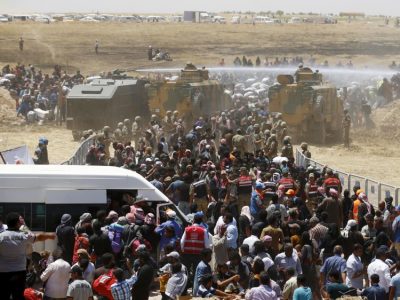Turkey’s “Refugee City” Proposal for Syria Amounts to Demographic Engineering

Turkish President Erdogan’s recently announced proposal to build a “refugee city” in Northern Syria amounts to demographic engineering intended to stop the creation of a “Kurdish Corridor” there and also prevent the region from fully reintegrating into Damascus’ fold after the war.
Turkish President Erdogan proposed the building of a “refugee city” in Northern Syria after the latest trilateral talks with his Russian and Iranian counterparts in Ankara, declaring that
“for the refugees there (on the Syrian border), it is necessary to create a city for them to participate in agriculture. I explained to my colleagues that it is necessary to build infrastructure for them. It is necessary to prevent the formation of a terrorist corridor.”
The stated intention of his plans makes no secret of the fact that they’re supposed to thwart the creation of a “Kurdish Corridor” and therefore reinforce Turkey’s national security through the nascent “buffer zone” that it’s carving out there, which also implies that more than one “refugee city” would have to eventually be established in order to sustainably accomplish this. On the surface, this proposal is being portrayed in such a way as to maximize the support that it receives from the International Community, but it’s actually not as “purely” intended as it may seem.
Turkey’s self-interested reasons in massively returning the millions of refugees that came to its territory during the war do indeed overlap with some of the multilateral interests shared by the International Community, but the means through which they’re being pursued are a lot less noble. It’s true that the US-backed Syrian Kurds have conquered territory beyond their traditional regions in the country (where they only rarely constituted a majority in just a few local communities anyhow) and that there are credible reasons for believing that they’ve carried out ethnic cleansing against the indigenous Arab and “Turkmen” (a trendy term for simply referring to Syrian Turks) populations there, but it’s equally true that Turkey’s “refugee city” proposal also amounts to a form of demographic engineering too, and not just in the sense of returning Northern Syria back to its pre-war status (which is practically impossible to ever do anyhow). Only a fraction of the refugees and other Syrians that came to Turkey since 2011 are from that region, so literal “outsiders” would end up being relocated there.
They, however, aren’t being considered by Turkey as such because of their nationality as Syrians and their ethnicity as either Arabs or “Turkmen”, with the unstated notion being that citizens of the same country should have the right to move anywhere within its territory that they’d like. While that approach is generally the legal standard in most states, it’s clearly being exploited in this case for self-interested demographic but also geopolitical reasons. About the first-mentioned and going beyond the obvious intent of stopping the creation of a “Kurdish Corridor”, Turkey wants to populate this sparely inhabited region with non-Kurds in order to prevent the latter from ever reviving their expansionist dreams in the future, which they’ve since “moderated” by attempting to become “more inclusive” by emphasizing their political goal of “autonomy” instead of the blatant ethnic chauvinism that used to characterize their movement. To assist with Ankara’s ambitions, it’s likely going to rely on anti-government Syrians (both Arabs and “Turkmen” alike), which conforms with its geopolitical goals.
Although no universally accepted figures have ever been released, it’s widely thought that the majority of Syrians who moved to Turkey after 2011 are opposed to their country’s democratically elected and legitimate government, and this group of people regularly claims that they don’t feel safe returning back to their homes in the now-liberated majority of the country where they used to reside because they don’t trust the authorities to guarantee their well-being and truly ensure that no legal or other consequences befall them. For the record, the Syrian government has invited them to return and even recently issued a broad amnesty, though those folks still refuse to come back for whatever their personal and/or political reasons may be. Nevertheless, Turkey also doesn’t want to continue indefinitely hosting them, especially if there’s another influx of incomers in the event that the situation deteriorates even more around Idlib, hence why it wants to relocate all of them (both the minority of those originally from the North and everyone else from elsewhere alike) to Northern Syria.
Should this plan even partially succeed, then it would create a major stumbling block to Damascus’ drive to reintegrate that part of the country into the national fold without granting it special status like its future inhabitants might demand in exchange. Furthermore, that “refugee city” (or very likely “cities”) will probably be defended by the Turkish military for at least a transitional period and then secured through pro-Turkish armed proxies, thus making it even more difficult for Damascus to reintegrate with that region and its possibly significantly sized population without making political “concessions” such as the granting of autonomy whether for the whole region or just specific municipalities. All told, it’s understandable why Turkey is pushing for the implementation of its “refugee city” proposal because it strongly advances its strategic interests in Syria, though the most responsible members of the International Community should ask themselves if the end truly justifies the means, and if not, whether they’re even capable of modifying these plans or if they’re already a fait accompli.
*
Note to readers: please click the share buttons above or below. Forward this article to your email lists. Crosspost on your blog site, internet forums. etc.
This article was originally published on OneWorld.
Andrew Korybko is an American Moscow-based political analyst specializing in the relationship between the US strategy in Afro-Eurasia, China’s One Belt One Road global vision of New Silk Road connectivity, and Hybrid Warfare. He is a frequent contributor to Global Research.
Featured image is from OneWorld

